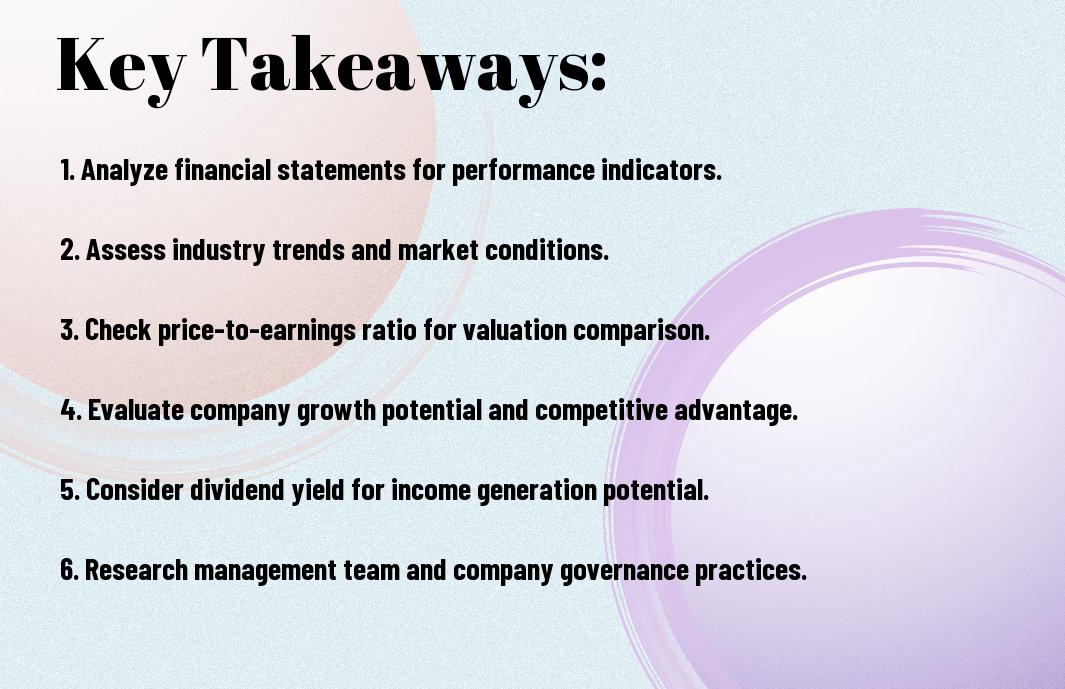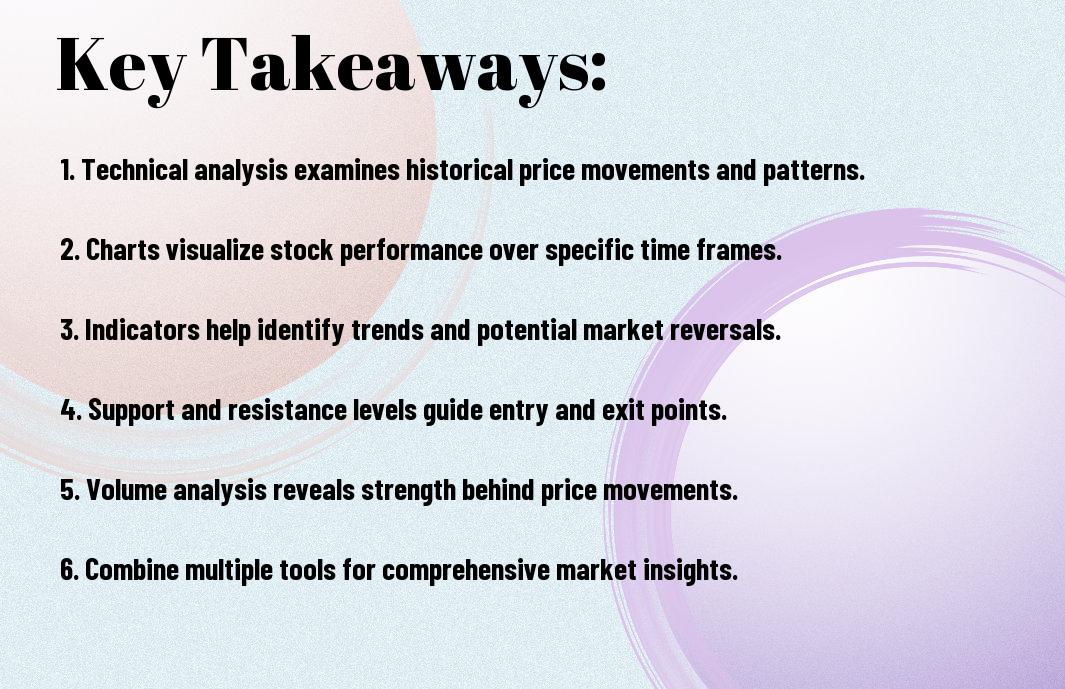Valuing a stock before buying is an imperative step in making informed investment decisions. By understanding the various methods and metrics at your disposal, you can better assess the potential of a company and its stock price. This guide will walk you through the key techniques to evaluate a stock’s worth, helping you find opportunities that align with your investment goals. Whether you’re a novice or an experienced investor, mastering stock valuation will empower you to make choices that could enhance your financial future.

Key Takeaways:
- Understand Financial Ratios: Analyze important financial ratios like P/E ratio, P/B ratio, and dividend yield to assess a stock’s valuation.
- Assess Company Performance: Review the company’s revenue growth, profit margins, and overall financial health to gauge its potential for future success.
- Industry Comparison: Compare the stock with its peers in the same sector to evaluate how it stacks up against similar companies.
- Economic Factors: Consider broader economic indicators such as interest rates, inflation, and market trends that could impact the stock’s performance.
- Future Growth Potential: Look into the company’s growth prospects, including new products, market expansion, and competitive advantages.

Understanding Stock Valuation
Your ability to value stocks effectively is fundamental to making informed investment decisions. Stock valuation involves analyzing various financial metrics and market conditions to determine a stock’s intrinsic value. This process helps you differentiate between undervalued and overvalued stocks, enabling you to buy wisely and enhance your investment portfolio’s performance.
Importance of Valuing Stocks
Importance of valuing stocks lies in minimizing potential losses and maximizing returns. By assessing a stock’s true worth, you can identify opportunities and avoid overpaying for investments. Valuation not only helps you understand market sentiment but also aids in aligning your investment strategy with long-term financial goals.
Key Financial Metrics
Any effective stock valuation requires an understanding of key financial metrics such as Price-to-Earnings (P/E) ratio, Earnings Per Share (EPS), and price-to-book (P/B) ratio. These metrics provide insights into a company’s profitability, market performance, and overall financial health, allowing you to make accurate comparisons between different stocks.
To value a stock accurately, focus on important metrics like the P/E ratio, which reveals how much investors are willing to pay for a dollar of earnings. The EPS indicates a company’s profitability on a per-share basis and gives context to its financial performance. Additionally, the P/B ratio compares a company’s market value to its book value, highlighting whether it is undervalued or overvalued. Analyzing these metrics together will enhance your understanding of a stock’s overall potential and guide your decision-making process.
Fundamental Analysis
Clearly, fundamental analysis is important when valuing a stock before making an investment. By assessing a company’s financial health and performance metrics, you can determine if a stock is undervalued or overvalued. For a comprehensive understanding, refer to The Definitive Guide: How to Value a Stock. This method enables you to make informed decisions based on solid data rather than market hype.
Analyzing Financial Statements
Among the first steps in fundamental analysis is analyzing financial statements. The balance sheet, income statement, and cash flow statement provide key insights into the company’s financial health. Understanding these documents helps you gauge profitability, asset management, and overall financial stability.
Evaluating Earnings and Revenue
Analyzing earnings and revenue is imperative to assess a company’s performance. Revenue growth indicates a company’s ability to increase sales, while earnings reveal how effectively it is translating revenue into profit. A consistent track record of rising earnings usually suggests a strong business model.
Statements from financial reports often show trends in earnings and revenue over time. You should look for patterns such as consistent year-over-year revenue growth or fluctuations in profit margins. These insights can highlight the company’s resilience during economic fluctuations and its potential for future growth. Focus on one-off events that may skew earnings figures, as these can paint an inaccurate picture of the company’s true financial performance.
Market Ratios
Keep in mind that market ratios are key metrics that help you gauge a stock’s value relative to its earnings, book value, and market price. By analyzing these ratios, you can make informed decisions on whether or not a stock is worth your investment based on its performance compared to industry standards and competitors.
Price-to-Earnings Ratio (P/E)
Before investing, consider the Price-to-Earnings (P/E) ratio, which compares a company’s current share price to its earnings per share (EPS). A lower P/E may indicate that the stock is undervalued, while a higher P/E could suggest overvaluation. Evaluating the P/E ratio in conjunction with industry peers helps you understand if a stock is appropriately priced.
Price-to-Book Ratio (P/B)
Around the valuation metrics, the Price-to-Book (P/B) ratio also plays an crucial role. This ratio compares a company’s market value to its book value, helping you assess if the stock is undervalued or overvalued relative to its assets.
This ratio can be particularly useful for comparing companies within capital-intensive industries where tangible assets are significant. A P/B ratio under 1 might indicate that the stock is trading for less than its intrinsic value, while a ratio above 1 suggests it’s trading at a premium. Analyzing the P/B ratio alongside the P/E and other financial metrics can provide a comprehensive understanding of a company’s valuation.
Discounted Cash Flow Analysis
After you’ve gathered the necessary information about a company, the next logical step is to conduct a Discounted Cash Flow (DCF) analysis. This method helps you estimate the company’s intrinsic value by projecting its future cash flows and discounting them back to their present value. Understanding DCF gives you insight into whether a stock is undervalued or overvalued, enabling you to make informed investment decisions.
Estimating Future Cash Flows
Beside calculating the present value, your DCF analysis begins with estimating future cash flows. This involves forecasting the company’s revenue, expenses, and ultimately, its free cash flow over a defined time horizon. You should consider historical performance, market conditions, and growth prospects to create realistic cash flow projections.
The Discount Rate Explained
With the future cash flows in hand, determining the discount rate is the next step. This rate reflects the time value of money, accounting for the risk associated with the investment. A higher discount rate indicates greater risk, while a lower rate suggests a more stable investment. By applying this rate to your projected cash flows, you can gauge their present value, helping you ascertain if the stock price rightly reflects its potential.
To select an appropriate discount rate, consider the company’s weighted average cost of capital (WACC), which includes the cost of equity and debt. This rate should not only reflect the risks of the investment but also allow you to compare different opportunities accurately. Adjusting the discount rate based on company-specific risks, economic conditions, and your own required return will enhance the reliability of your DCF analysis and the accuracy of your investment decisions.
Comparing Industry Benchmarks
All investors should assess a stock’s value by comparing it to industry benchmarks. This process helps you understand how the stock performs relative to its peers and where it stands in the market. By evaluating key metrics such as P/E ratios, dividend yields, and growth rates, you can make informed decisions based on broader industry performance.
Industry Averages and Comparisons
| Metric | Average Industry Value |
|---|---|
| P/E Ratio | 20 |
| Dividend Yield | 3% |
| Growth Rate | 5% |
Industry Averages and Comparisons
Between different sectors, you will find varying averages for financial metrics. Monitoring these benchmarks allows you to gauge a specific company’s performance and profitability relative to its competitors. If a stock’s ratios significantly deviate from the industry averages, it could indicate an opportunity or a potential risk that requires deeper investigation.
Identifying Market Trends
Between analyzing historical data and understanding consumer behavior, identifying market trends is crucial for your investment strategy. Trends can indicate the overall direction of an industry, helping you to pinpoint stocks that are likely to outperform based on their alignment with these themes.
At the same time, market trends can shift rapidly due to economic changes, technological advances, or evolving consumer preferences. Staying updated with news, reports, and expert analyses will ensure that you remain aware of significant trends that may impact your investment decisions. By incorporating these insights, you can better position your stock purchases to align with prevailing market conditions.
Qualitative Factors in Stock Valuation
Once again, evaluating qualitative factors is imperative in stock valuation, as they provide insights beyond numbers. Consider aspects such as:
- Management quality
- Company strategy
- Market position
- Competitive advantage
After assessing these factors, you can achieve a more comprehensive understanding of the stock’s potential.
Management and Company Strategy
An effective management team plays a vital role in a company’s success. You should evaluate their track record, expertise, and accountability. Additionally, consider the company’s strategy for growth and profitability, as this can directly influence its long-term performance and stock valuation.
Market Position and Competitive Advantage
Strategy is imperative when assessing a company’s market position and competitive advantage. Understanding how a company differentiates itself from competitors will help you gauge its potential for sustainable growth.
Competitive advantages can arise from factors such as unique products, strong brand loyalty, or cost leadership. By identifying these advantages, you can better determine how the company is positioned within its industry. Furthermore, analyze your company’s ability to maintain or enhance its market share over time, as this can significantly impact its valuation and your investment decision.
Summing Up
Now that you understand the key methods for valuing a stock, you can make informed decisions before investing. Assess the company’s financial health through metrics like price-to-earnings ratios and cash flow analysis, while also considering market trends and competitive positioning. Evaluating both qualitative and quantitative factors will enhance your perspective on potential investments. Take your time to conduct thorough research, as finding value in a stock can ultimately lead to greater returns on your investment.
Q: What are the main financial metrics to consider when valuing a stock?
A: When valuing a stock, there are several key financial metrics to analyze. First, look at the Price-to-Earnings (P/E) ratio, which compares a company’s current share price to its earnings per share (EPS). A lower P/E ratio may indicate that the stock is undervalued compared to its earnings. Next, examine the Price-to-Book (P/B) ratio, which compares a company’s market value to its book value; a lower P/B ratio can suggest the stock is trading at a discount. Additionally, consider the dividend yield, which gives insight into the income you might receive as an investor from dividends relative to the stock price. Lastly, review metrics like the Debt-to-Equity ratio to assess financial risk, and the Return on Equity (ROE) to understand how effectively a company is using its equity to generate profits.
Q: How do industry comparisons help in evaluating a stock’s value?
A: Industry comparisons are crucial when evaluating a stock’s value, as they provide context for a company’s performance relative to its peers. By analyzing key metrics such as P/E and P/B ratios within the same industry, investors can determine whether a stock is overvalued or undervalued compared to competitors. Additionally, examining industry trends and growth rates can offer insights into the potential future performance of a company. It’s beneficial to look at industry benchmarks and averages to understand how the stock compares in terms of profitability, revenue growth, and risk profile. This benchmark analysis helps investors make more informed decisions about the stock’s potential and its market position.
Q: What qualitative factors should be considered when valuing a stock?
A: In addition to quantitative metrics, qualitative factors play an important role in valuing a stock. Consider the company’s management team, as effective leadership can significantly impact a company’s performance and strategic direction. Analyze the company’s competitive advantages, such as unique products, market share, patents, or strong brand loyalty, as these can contribute to long-term success. Additionally, assess the overall market conditions and economic environment, which can affect a company’s prospects. Finally, keep an eye on any regulatory changes or industry disruptions that may influence the stock’s value. Incorporating these qualitative aspects alongside quantitative metrics can provide a comprehensive view when evaluating a stock for potential investment.



